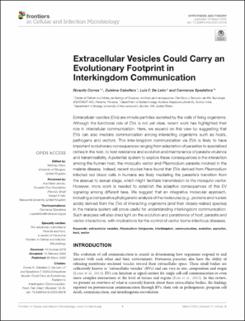Mostrar el registro sencillo del ítem
Extracellular Vesicles Could Carry an Evolutionary Footprint in Interkingdom Communication
| dc.contributor.author | Correa, Ricardo | |
| dc.contributor.author | Caballero, Zuleima | |
| dc.contributor.author | Luis Fernando, De León | |
| dc.contributor.author | Spadafora, Carmenza | |
| dc.date.accessioned | 2020-05-27T18:46:14Z | |
| dc.date.available | 2020-05-27T18:46:14Z | |
| dc.date.issued | 2020-03-03 | |
| dc.identifier.other | https://doi.org/10.3389/fcimb.2020.00076 | |
| dc.identifier.uri | http://repositorio-indicasat.org.pa/handle/123456789/29 | |
| dc.description | Extracellular vesicles (EVs) are minute particles secreted by the cells of living organisms. Although the functional role of EVs is not yet clear, recent work has highlighted their role in intercellular communication. Here, we expand on this view by suggesting that EVs can also mediate communication among interacting organisms such as hosts, pathogens and vectors. This inter-kingdom communication via EVs is likely to have important evolutionary consequences ranging from adaptation of parasites to specialized niches in the host, to host resistance and evolution and maintenance of parasite virulence and transmissibility. A potential system to explore these consequences is the interaction among the human host, the mosquito vector and Plasmodium parasite involved in the malaria disease. Indeed, recent studies have found that EVs derived from Plasmodium infected red blood cells in humans are likely mediating the parasite's transition from the asexual to sexual stage, which might facilitate transmission to the mosquito vector. However, more work is needed to establish the adaptive consequences of this EV signaling among different taxa. We suggest that an integrative molecular approach, including a comparative phylogenetic analysis of the molecules (e.g., proteins and nucleic acids) derived from the EVs of interacting organisms (and their closely-related species) in the malaria system will prove useful for understanding interkingdom communication. Such analyses will also shed light on the evolution and persistence of host, parasite and vector interactions, with implications for the control of vector borne infectious diseases. | en_US |
| dc.description.abstract | Extracellular vesicles (EVs) are minute particles secreted by the cells of living organisms. Although the functional role of EVs is not yet clear, recent work has highlighted their role in intercellular communication. Here, we expand on this view by suggesting that EVs can also mediate communication among interacting organisms such as hosts, pathogens and vectors. This inter-kingdom communication via EVs is likely to have important evolutionary consequences ranging from adaptation of parasites to specialized niches in the host, to host resistance and evolution and maintenance of parasite virulence and transmissibility. A potential system to explore these consequences is the interaction among the human host, the mosquito vector and Plasmodium parasite involved in the malaria disease. Indeed, recent studies have found that EVs derived from Plasmodium infected red blood cells in humans are likely mediating the parasite's transition from the asexual to sexual stage, which might facilitate transmission to the mosquito vector. However, more work is needed to establish the adaptive consequences of this EV signaling among different taxa. We suggest that an integrative molecular approach, including a comparative phylogenetic analysis of the molecules (e.g., proteins and nucleic acids) derived from the EVs of interacting organisms (and their closely-related species) in the malaria system will prove useful for understanding interkingdom communication. Such analyses will also shed light on the evolution and persistence of host, parasite and vector interactions, with implications for the control of vector borne infectious diseases. | en_US |
| dc.language.iso | en | en_US |
| dc.publisher | Frontiers | en_US |
| dc.subject | extracellular vesicles | en_US |
| dc.subject | Plasmodium falciparum | en_US |
| dc.subject | interkingdom | en_US |
| dc.subject | communication | en_US |
| dc.subject | evolution | en_US |
| dc.subject | parasites | en_US |
| dc.subject | host | en_US |
| dc.subject | vector | en_US |
| dc.title | Extracellular Vesicles Could Carry an Evolutionary Footprint in Interkingdom Communication | en_US |
| dc.type | Article | en_US |

